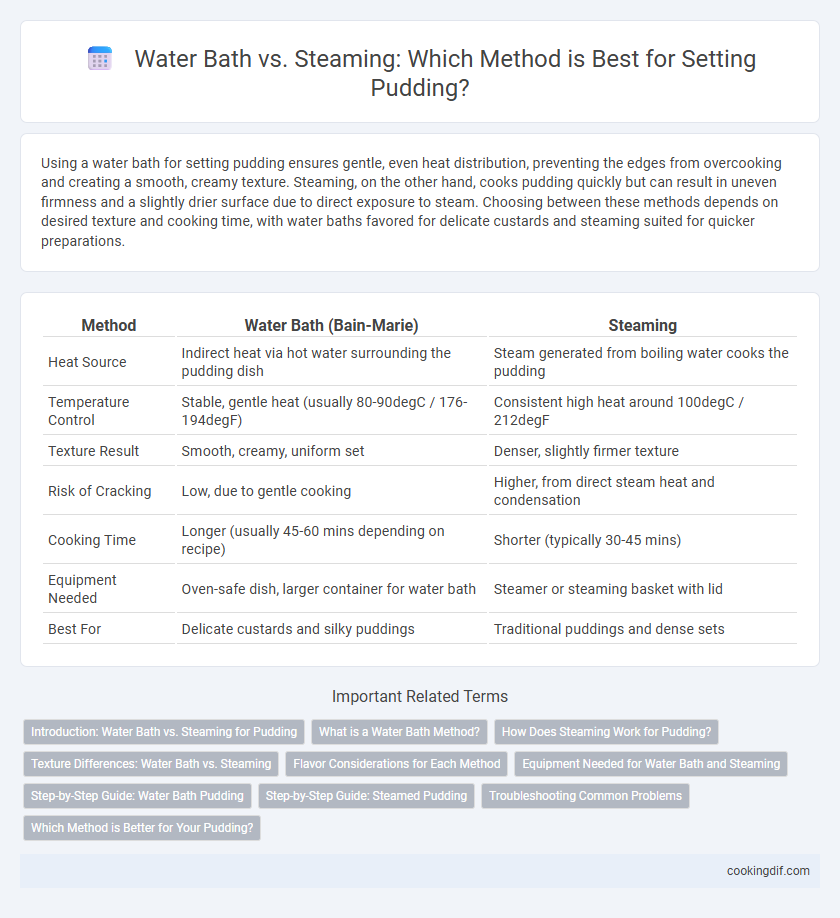Using a water bath for setting pudding ensures gentle, even heat distribution, preventing the edges from overcooking and creating a smooth, creamy texture. Steaming, on the other hand, cooks pudding quickly but can result in uneven firmness and a slightly drier surface due to direct exposure to steam. Choosing between these methods depends on desired texture and cooking time, with water baths favored for delicate custards and steaming suited for quicker preparations.
Table of Comparison
| Method | Water Bath (Bain-Marie) | Steaming |
|---|---|---|
| Heat Source | Indirect heat via hot water surrounding the pudding dish | Steam generated from boiling water cooks the pudding |
| Temperature Control | Stable, gentle heat (usually 80-90degC / 176-194degF) | Consistent high heat around 100degC / 212degF |
| Texture Result | Smooth, creamy, uniform set | Denser, slightly firmer texture |
| Risk of Cracking | Low, due to gentle cooking | Higher, from direct steam heat and condensation |
| Cooking Time | Longer (usually 45-60 mins depending on recipe) | Shorter (typically 30-45 mins) |
| Equipment Needed | Oven-safe dish, larger container for water bath | Steamer or steaming basket with lid |
| Best For | Delicate custards and silky puddings | Traditional puddings and dense sets |
Introduction: Water Bath vs. Steaming for Pudding
Water bath and steaming are two popular methods for setting pudding, each offering distinct texture outcomes. A water bath, or bain-marie, provides gentle and even heat, preventing overcooking and producing a smooth, creamy pudding. Steaming delivers moist heat more rapidly, often resulting in a lighter, slightly firmer texture ideal for traditional custard-based puddings.
What is a Water Bath Method?
The water bath method involves placing a pudding dish inside a larger pan filled with hot water to ensure even, gentle cooking and prevent cracking. This technique maintains consistent moisture and temperature around the pudding, resulting in a smooth, creamy texture. Water baths are particularly effective for delicate custards and cheesecakes that require slow, uniform heat distribution.
How Does Steaming Work for Pudding?
Steaming sets pudding by surrounding it with moist, hot air, which gently cooks the mixture and prevents the surface from drying out or cracking. The consistent steam temperature, typically around 100degC (212degF), allows the pudding to cook evenly, resulting in a smooth and creamy texture. This method preserves moisture better than a dry oven environment, making it ideal for delicate custards and milk-based puddings.
Texture Differences: Water Bath vs. Steaming
Water bath cooking creates a gentle, even heat that results in a smooth and creamy pudding texture by preventing curdling and overcooking. Steaming produces a slightly firmer texture with a more pronounced surface skin, as the direct steam heat cooks the pudding faster and can cause uneven heat distribution. The water bath method is preferred for custard-based puddings requiring delicate consistency, while steaming suits firmer, traditional pudding varieties.
Flavor Considerations for Each Method
Water bath cooking for pudding ensures even heat distribution, preserving delicate flavors and preventing caramelization that can alter the taste. Steaming retains more moisture, resulting in a softer texture but can dilute subtle flavor notes due to higher humidity. Choosing between the two methods depends on whether the goal is to highlight rich, concentrated flavors (water bath) or achieve a light, tender consistency with mild flavor intensity (steaming).
Equipment Needed for Water Bath and Steaming
Water bath for setting pudding requires a deep roasting pan or baking dish filled with hot water to ensure gentle, even heat, along with oven-safe ramekins and aluminum foil to prevent water ingress. Steaming demands a steamer pot or bamboo steamer placed over boiling water, plus heatproof bowls or molds that fit securely within the steamer basket. Both methods need heat-resistant equipment, but water baths necessitate an oven setup while steaming relies on stovetop equipment.
Step-by-Step Guide: Water Bath Pudding
Using a water bath to set pudding ensures even heat distribution, preventing curdling and producing a smooth, creamy texture. Begin by preheating the oven to the recommended temperature and placing the filled pudding dishes in a larger baking pan. Pour hot water into the pan until it reaches halfway up the sides of the pudding containers, then bake until the custards are just set and slightly wobbly in the center.
Step-by-Step Guide: Steamed Pudding
Steamed pudding involves placing the mixture in a heatproof mold, covering it tightly with foil, and steaming it over simmering water for the required time, usually 45-60 minutes depending on the recipe. This method provides gentle, consistent heat that prevents curdling and ensures a smooth, creamy texture by maintaining moist conditions throughout cooking. Unlike a water bath, steaming avoids direct water contact and can result in a slightly firmer pudding surface while locking in moisture effectively.
Troubleshooting Common Problems
Water bath provides gentle, even heat that helps prevent pudding from cracking or curdling by maintaining consistent temperature around the dish. Steaming sets pudding quickly but may cause uneven texture or watery spots if not properly controlled, leading to raw centers or overly dense edges. To troubleshoot common problems, ensure the water bath's water level stays consistent and covers half the pudding dish, while during steaming, regulate steam intensity and avoid direct contact with boiling water.
Which Method is Better for Your Pudding?
Using a water bath provides gentle, even heat that prevents pudding from curdling and ensures a smooth, creamy texture by maintaining consistent temperature. Steaming cooks pudding faster but can result in uneven heat distribution, potentially causing a less uniform set and slight texture variations. For delicate custard-based puddings, a water bath is generally better for achieving a silky, tender consistency, while steaming suits denser puddings that need quicker setting.
Water bath vs steaming for setting pudding Infographic

 cookingdif.com
cookingdif.com